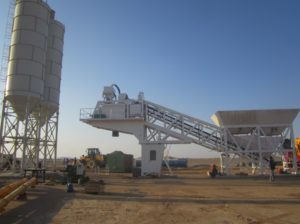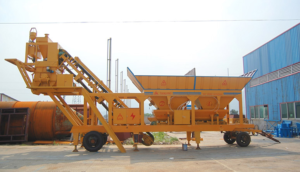The mobile batch plant, also known as a portable concrete plant is a very productive, reliable and cost effective piece of equipment to produce batches of concrete. It allows the user to batch concrete at most any location then move to another location and batch concrete. It was invented in 1956 by Vince Hagan and was patented in 1966 as a convenient alternative to stationary batch plants that cannot be moved easily (U.S. patent #3,251,484). Portable plants are the best choice for temporary site projects or even stationary locations where the equipment height is a factor or the required production rate is lower.

Parts of a Mobile Batch Plant
A typical portable plant is a single unit that is pulled by a fifth wheel tractor. Within this unit there is typically a silo for holding cement and/or fly ash, an aggregate bin and batcher, an aggregate conveyor and the cement batcher. A water batcher can be included and some manufacturers also offer integrated dust collectors as well.
The silos for storing cement can vary in size from a couple hundred barrels up to 500 barrels [60 m3]. The silo can be divided to provide storage for both cement and fly ash. The division does not have to be equal; it can 50%-50%, 60%-40%, or whatever is required.
A separate unit can be used to house an auxiliary silo for the storage of fly ash, potash, or additional cement.
Aggregate Bin Functions
The aggregate bin may or may not travel as part of the unit based on size and weight. These bins can hold up to 150 tons of sand and aggregate (rocks, gravel, etc.). The bin is typically divided into 3 or 4 compartments to allow various sand and aggregate sizes to be stored and released into the aggregate batcher in predetermined ratios.
The aggregate bin can be loaded directly with a front-end loader, but more often is loaded by one or more conveyors that are equipped with a hopper that can be loaded by a front-end loader. These conveyors, also called stackers, can be designed to move side-to-side to allow a single conveyor to feed multiple bin compartments. These movable conveyors are referred to as Radial Stackers as they pivot from their loading hopper.
The aggregate batcher is the hopper that measures by weight the sand and aggregate before it is transferred to the mixer or truck. The batcher is supported on a series of load cells and is sized based on the plant’s published capacity and can typically range from 8 cubic yards [6 m3] up to 14 cubic yards [10 m3].
Other Part Functions

The sand and aggregate released from the batcher are carried by the transfer belt conveyor. The conveyor can range in width from 24” [600mm] up to 48” [1200mm] wide and uses troughed rollers to unsure that the material does not spill off of the sides.
Cement and fly ash from the silos is typically transferred to the cement batcher via screw conveyors or gravity fed directly from an overhead silo. Screw conveyors provide a method of transport that allows the concrete constituents to remain dry until it is time for them to be mixed with water.
The cement batcher serves the same purpose as the aggregate batcher, but for the cement and fly ash. Unlike the aggregate batcher the cement batcher is enclosed so that, like the screw conveyors, the material in it remains dry.
Some portable plant can be equipped with a weighed water batcher as well. This will hold sufficient water for a single batch of concrete and is supported on several load cells to verify the amount of water.
Finally, there must be a method by which the dust created during the handling and transfer of the various constituents can be collected. Most manufacturers offer dust collection systems that must be transported separate from the plant itself. Again, Haomei was the first to offer integrated dust collectors that travel with the plant and do not require a separate load of freight.
Hydraulic Batch Plant Systems
Historically, the erection of a portable plant required to use of a crane to lift the plant as well as the auxiliary silo, if used, into place. Portable Batch Plants are now available with hydraulic systems that will complete the erection without the use of a crane.
Automation and Control
Computers aid in controling mobile batch plants to ensure movements are accurate and input of ingredients is consistent. Computer aided control also helps to increase safety, as they control all pieces of the batch plant at once in coordination.